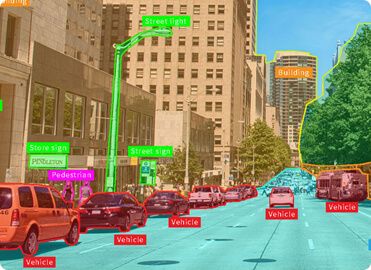Image Recognition and its Applications

Artificial intelligence has led to incredible innovations like robotics, autonomous vehicles, and intelligent assistants of Image recognition. However, like every unique & new technology, it needs assistance to cause such transformational outcomes.
Similarly, that’s where recognition of image comes in- to facilitate identification and interpretation in a digital photo and use that information to enhance AI-assisted decision-making.
Let’s start with what image annotation is, why it’s essential for businesses, and how it works. Firstly, we shall also discuss its use cases, applications, and where recognition of image services fare in this equation.
What is Image Recognition?
It is a technology that analyzes images. It detects and identifies features in a digital photo or video. Above all, the extracted information is used to enable task automation.
Moreover, this technology can identify people, places, animals, objects, and many other elements within an image or video and conclude by analyzing them.
Here are some real-world examples of image recognition:
- X-ray labeling to spot cancerous cells
- Assigning a name to a photographed face (“tagging” on social media channels like Facebook, Twitter, Snapchat, Instagram, etc.)
- Recognizing handwriting by segmenting a letter
Why Is Image Recognition Important?
It is the most fundamental computer vision task.
Similarly, its numerous standalone applications and widely accepted functionality make it essential for artificial intelligence and machine learning projects. It enables several transforming user experiences, including:
- Automated image organization
- User-generated (USG) content moderation
- Upgraded visual search
- Automatic tagging
- Interactive marketing campaigns
Obviously, this isn’t an extensive list.
Modules:
As already stated, we use image annotation for various purposes.
Depending on the project requirements, we perform recognition of image at multiple precision levels. To do so, we divide the process into different modules and combine them as needed to create the desired outcomes.
Among all the modules, these are the more widely and frequently used.
⇒ Object Detection
Object detection is a technique that identifies and locates objects in a digital image or video. It helps count objects in a frame while accurately labeling them.
⇒ Image Classification
Image classification- a technique of categorizing and labeling a group of pixels within an image. It’s a vital part of computer vision. However, allowing machines to see the world as we do.
Using two types:
- Single-label Classifications
- Multi-label Classifications
⇒ Segmentation
After that, Image segmentation is a method of breaking down digital images into subgroups called segments. It helps reduce the image complexity and makes further processing easier.
Image Recognition Use Cases:
Now that we know what recognition of image is, why it is essential, and its modules, let’s explore its use cases.
Here, we’ll discuss how this technology can be used in the following areas:
- Content Moderation
- Visual Search
- Accessibility
- Image Organization
-
Content Moderation
Many content-sharing communities exist because of user-generated content’s dependable and authentic flow. For instance, But a high volume of USG in any community brings a challenge — authenticating the content to ensure it adheres to community guidelines.
However, content moderation plays a significant role. It ensures that community spaces are centered, safe, and accomplish intended purposes, all possible with the tech stack of recognition of image.
2. Visual Search
Visual search uses real-life images as a query to generate reliable, precise online results. It is very effective in eCommerce where it allows sellers to suggest products related to the image provided by shoppers. Otherwise, it answers general user questions by basing the search on an image.
However, using AI-Powered image recognition lets businesses understand the image’s context more efficiently, thus allowing customized and responsive lists of related results.
3. Accessibility
The most promising recognition of image application is the transition of visual content into accessible formats for visually impaired individuals.
By using this technology, we can convey the information stored in the image to the user’s intended medium, like Braille screens or screen readers.
4. Image Organization
The modern smartphone era has made it easier to snap limitless high-quality photos and videos. However, with massive content volume, another complication arises — finding efficient ways for content organization.
In other words, content organization (including photos and videos) is effortless with image recognition. It ensures:
- Better Receptiveness
- Smooth Content Sharing
- Improved Search & Discovery
Applications of Image Recognition :
Firstly, many of the image-recognition use cases we discussed have been implemented in real-life solutions.
In this section, we’ll discuss some of those applications.
- Automotive Industry
- Security Industry
- Healthcare Industry
- Retail Industry
- E-Commerce Industry
- Agriculture Industry
⇒ Automotive Industry
Firstly, the technology behind self-driving vehicles is highly associated with image recognition.
Here is how it happens:
Step 1: Multiple cameras and LIDAR technology fitted in vehicles create the images.
Step 2: These images are processed using image recognition to detect vehicles, lights, or any other objects.
Step 3: That information is fed to deep neural networks to establish a context for the image.
In other words, when a computer vision model uses this information, it can easily decide the path for the vehicle while also considering the safety of everyone else on the road.
⇒ Security Industry
Image recognition technology plays a significant role in the security industry. It identifies and detects a person’s face and then consults a database to find a match. It is an effective system for identification purposes.
Banks, offices, casinos, restaurants, homes, and other organizations are also interested in AI-Powered Image recognition, and many have already embraced some sort of face tracking mechanism.
⇒ Healthcare Industry
Image recognition is becoming a new norm in the healthcare sector. Similarly, from computer-aided diagnostics and mood recognition in therapy to keeping track of patients and combating the spread of deadly COVID-19, image recognition has helped in many areas.
Key Usage Of Image Recognition In the Healthcare Industry:
- Patient Check-in and Check-Out Procedures
- Diagnosing Diseases and Conditions
- Image Recognition To Ensure COVID-19 Guidelines
- Emotion Detection, etc.
⇒ Retail Industry
Firstly, many retailers are adopting image recognition for easier customer analytics, counterfeit detection, customized searches, etc.
Moreover, the technology provides retailers with enough information to help them design and implement effective marketing campaigns and improve their conversion rate.
⇒ E-Commerce Industry
Firstly, it is shaping the eCommerce industry.
Shopper’s buying habits are becoming more visually inclined. In addition, they seek convenience and comfortable shopping experiences. For instance, as a result, giant E-commerce marketplaces & online platforms track consumer behaviors and shape their buying journeys accordingly.
In Conclusion, that endeavor heavily leans on image recognition technology and its uses.
For example, The biggest search engine ‘Google’ has launched its image annotation app, Google Lens. Now, a user can simply tap any image on their phone and hold it. Google Lens will find a similar or related product and display sources immediately.
⇒ Agriculture Industry
It has become an essential technology in the Agriculture industry. Secondly, it allows precision farming. For instance, further, it helps observe, measure, and respond to crop variability.
Moreover, it enables farmers to analyze crop images taken from drones to collect yield data, identify weed growth, or detect nutrient deficiencies.
Image Recognition Services — The Best Approach To Getting Stellar Results
Above all, today massive volumes of data are captured in digital images or videos. Also, this brings along a challenge — how to effectively extract and optimize data to-
- Gain customer behavior insight
- Optimize product placement.
- Manufacture higher-quality goods by detecting defects
- Detect fraud
- Detect identity threats
For organizations looking to effectively extract and optimize data to gain valuable insight. However, we recommend outsourcing this task to an image recognition services provider. Doing so will get you many advantages in addition to the better outcomes you seek.
- Quick solutions
- Expert assistance
- Minimal distraction from core activities
- Advanced infrastructure support




